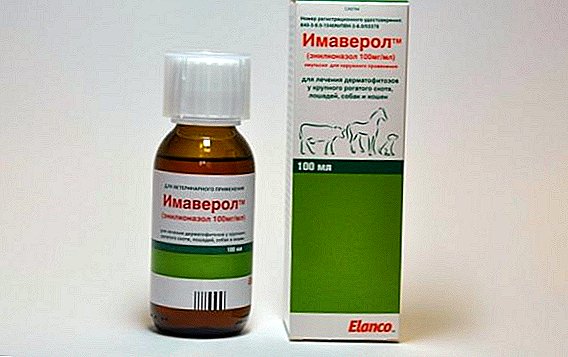 The vast majority of domestic animals that have wool, at least once in their lives suffered from deprived. Any livestock breeder knows perfectly well that this is an extremely contagious disease, which is transmitted from one individual to another with great speed, therefore, in order to completely get rid of this scourge, especially if it occurs in herds of cattle, it is necessary to use special medications. One of the best of these drugs is Imaverol, which helps a lot from the lichen caused by trichophytosis and microsporia. About him and will be discussed in this article.
The vast majority of domestic animals that have wool, at least once in their lives suffered from deprived. Any livestock breeder knows perfectly well that this is an extremely contagious disease, which is transmitted from one individual to another with great speed, therefore, in order to completely get rid of this scourge, especially if it occurs in herds of cattle, it is necessary to use special medications. One of the best of these drugs is Imaverol, which helps a lot from the lichen caused by trichophytosis and microsporia. About him and will be discussed in this article.
Composition, release form and packaging
The main substance that has a therapeutic effect in this drug is enilconazole. Its content in 1 ml of the drug is 100 mg. Polysorbate 20 and sorbitan laurate are used as auxiliary substances, the main task of which is to evenly distribute the drug over the entire surface of the animal's hair and increase the stability of this layer with respect to water. Their number in 1 ml of the drug is the same and is 486 mg.
Did you know? Mankind has long been familiar with such a disease as ringworm. The first mention of it was found in the wall paintings of the ancient Egyptian period. He also described it in the 1st century BC. e. Roman philosopher Tiberius Celsus.
 The preparation is packaged in plastic or glass bottles, the volume of which is 100 or 1000 ml. Each bottle is closed with a cap with primary opening control. The vials are packaged in cardboard boxes, which must contain the inscription "Imaverol", marking "for use in veterinary medicine," the addresses of production capacity of manufacturers and a brief description of the drug.
The preparation is packaged in plastic or glass bottles, the volume of which is 100 or 1000 ml. Each bottle is closed with a cap with primary opening control. The vials are packaged in cardboard boxes, which must contain the inscription "Imaverol", marking "for use in veterinary medicine," the addresses of production capacity of manufacturers and a brief description of the drug.
Inside the box should also contain instructions with recommendations on the use of the drug. Inside the bottle is a liquid emulsion, transparent, fairly thick in density, yellow-brown shade. It has no pronounced organoleptic properties.
Pharmacological properties
Enilconazole, which has a central therapeutic effect in the preparation, belongs to synthetic antifungal substanceswhich are active against virtually all known types of trichophytia and microsporia.
The mechanism of action of this drug is based on the ability of Enilconazole to reduce the production of ergosterol by the fungus, which is one of the key components of the cell wall of the fungus, which results in the destruction of fungal cells, the loss of the further ability of the fungus to reproduce and its inevitable death.
Did you know? One of the first antibiotics discovered by mankind, penicillin, is a fungus in nature. Its antimicrobial properties were discovered in 1928 by Alexander Fleming.
If this drug is used according to the instructions (externally and in appropriate dosages), it practically does not penetrate into the circulatory system of the animal and does not have any pronounced systemic effects. Its half-life is approximately 14-16 hours. It is removed in the majority through the kidneys (with urine) and in small quantities with feces. 
Indications for use
In fact, the only reason for using this drug is the occurrence in animals (mainly those that have pronounced hairiness) ringworm. The symptom of this disease is the formation of a round shape and various sizes of bald spots on animal hair. The skin in these areas is altered: covered with scales, flaky, wet, red, or exfoliate.
Deprive can affect poultry (chickens, geese, turkeys), rabbits.
Dosing and Administration
Before treating your animals with Imaverol, you must first prepare a working emulsion, since the treatment with a clean preparation can entail poisoning of your animals and even lead to their death. The working emulsion is made by adding water to the contents of the vial in a ratio of 1 to 50. The resulting 0.2% solution is subsequently used to treat any animals.
Cattle
Cattle carry out the treatment of the affected skin, capturing with small areas of skin (1-2 cm), which are located next to the affected. Treatment includes 4 treatmentsbetween which it is necessary to withstand intervals of not less than 3-4 days.  Before processing, it is necessary to remove all crusts from the affected surface, as they carry a large amount of the pathogen. Removal is best done with a brush that is pre-moistened with a healing solution.
Before processing, it is necessary to remove all crusts from the affected surface, as they carry a large amount of the pathogen. Removal is best done with a brush that is pre-moistened with a healing solution.
Important! Milk received from cows that have been treated with this drug, you can drink no earlier than 48 hours after the last treatment. The milk produced in the first two days after treatment, however, can be used in animal feed after preliminary heat treatment.
Horses
The treatment of horses is performed identically with the treatment of cattle, with the only difference being that they are subject to more thorough combing due to more developed hair. If pathology has arisen in the area of the mane, it is necessary to carefully ensure that during the treatment the emulsion does not fall on the horse’s face and eyes.  Permission to slaughter cattle and horses should be given no earlier than 4 days after the last treatment. If, for one reason or another, the slaughter still had to be done - this meat can be used as animal feed.
Permission to slaughter cattle and horses should be given no earlier than 4 days after the last treatment. If, for one reason or another, the slaughter still had to be done - this meat can be used as animal feed.
Read also about the treatment of diseases of cows: pasteurellosis, ketosis, colibacteriosis of calves, mastitis, leukemia, diseases of hoof, udder edema.
Dogs and cats
The treatment cycle of "Imaverol" for dogs consists of 4-6 treatmentsbetween which there should be a gap of several days (usually 3-4). When applying the working solution to dogs, treatment should be carried out against the direction in which the wool grows. It is necessary to provide full coverage of the affected areas of the body with an emulsion, capturing significant gaps of healthy skin. Representatives of breeds with long hair before the treatment will be better to shave.
"Imaverol", according to the instructions, is not the most suitable drug for cats, however, veterinarians and experience in the use of livestock breeders show that its use is quite acceptable and gives good results. The scheme of application, in general, is similar to that in dogs. Representatives of small breeds, as well as kittens and puppies, are allowed to be processed by immersing them in a container with a therapeutic emulsion. 
Precautions and special instructions
When working with this drug, you must follow all general precautions that follow when using medicines. Animals are treated strictly with rubber gloves. It is necessary to prevent the drug from getting into open skin, mucous membranes and into the body.
Important! In case of contact with the open skin or mucous membranes, it is necessary to thoroughly wash the place of contact under cold running water, and in case of any symptoms, consult a specialist.
In the process of using this drug is not allowed to smoke, use food and fluids. After completion of work, discard disposable gloves or wash and dry reusable gloves, and then thoroughly treat your hands with soap and running water.
Contraindications and side effects
According to the degree of toxicity and health effects, this medicine belongs to 4 class of danger (low hazard substances). At the recommended dosages and when properly applied, it does not have a toxic, mutagenic, teratogenic, local irritant and allergic effect on the organism of animals and humans.  Allergic reactions may occur if the animal or person is hypersensitive to any component of the drug or the main active ingredient. The presence of such hypersensitivity should be regarded as the only contraindication to the use.
Allergic reactions may occur if the animal or person is hypersensitive to any component of the drug or the main active ingredient. The presence of such hypersensitivity should be regarded as the only contraindication to the use.
In case of overdose or in case of ingestion of the drug in large quantities, the animals develop intoxication syndrome, which is manifested by increased body temperature, anxiety, increased sweating, decreased appetite, aggressiveness, and in severe cases - vomiting and lethargy, turning into loss of consciousness.
For the fight against fungal diseases in veterinary medicine, the drugs Virotc and Lozeval are used.
Compatibility with other drugs
Perhaps a decrease in the effectiveness of the drug in the case of parallel use with it of other antifungal agents for external use. With the simultaneous use of antibiotics, side effects may occur in the form of intoxication syndrome, which occurs due to the summation of the toxic effect of these drugs on the body.  When using this drug together with antifungal agents intended for oral administration, there is an increase in the main effect, but there is a likelihood of an intoxication syndrome in the animal.
When using this drug together with antifungal agents intended for oral administration, there is an increase in the main effect, but there is a likelihood of an intoxication syndrome in the animal.
Term and storage conditions
Keep the drug must be out of the reach of children and animals, away from kitchen utensils and food, in a place closed from direct sunlight and moisture, at a temperature of from +5 ° С to +30 ° С. Shelf life: unopened - 3 years from the date of production, and after the bottle was opened - up to 3 months.
We hope that this article has helped you to figure out how to breed and use Imaverol for your animals with ringworm. The drug will help you in the fight against this disease, without causing damage to the animal's body.












